Quantive is now part of WorkBoard. Get to know WorkBoard:
Your team is deep into a strategic project when the leadership team hits pause. No warning, no explanation — just a sudden shift. Sound familiar?
When unexpected, these shifts can trigger a wave of negative emotions — anger, disappointment, insecurity, demotivation. You name it.
At the same time, the way we do business has evolved significantly:
86% of leaders see economic uncertainty as a key driver for adopting dynamic prioritization (Paychex).
Then:
- Why do these changes often create stress and internal friction?
- And how do you keep everyone aligned and moving forward when strategic priorities shift?
These are the questions we'll tackle in the sections ahead.
Why does changing strategic priorities cause problems?
It's no surprise that the unknown triggers stress. Organizational change management plays a crucial role in handling these stress triggers effectively.
However, what's less obvious is how strategic shifts are perceived differently by leaders and team members — and how these contrasting perspectives can create challenges.
By comparing both sides' expectations and reactions, we can better understand why change is stressful — and, more importantly, how to minimize its negative effects.
Key differences:
- Leaders see the big picture when strategizing. Employees focus on day-to-day work and how changes impact it.
- Leaders own strategic decisions and direction. Employees see strategy as something imposed on them.
- Leaders see change as a growth opportunity. Employees see change as a threat to stability and job security.
- Leaders assume the change is logical and self-explanatory. Employees miss the context and feel left out.
- Leaders focus on outcomes and execution. Employees feel the burden of adapting to new processes, tools, or expectations.
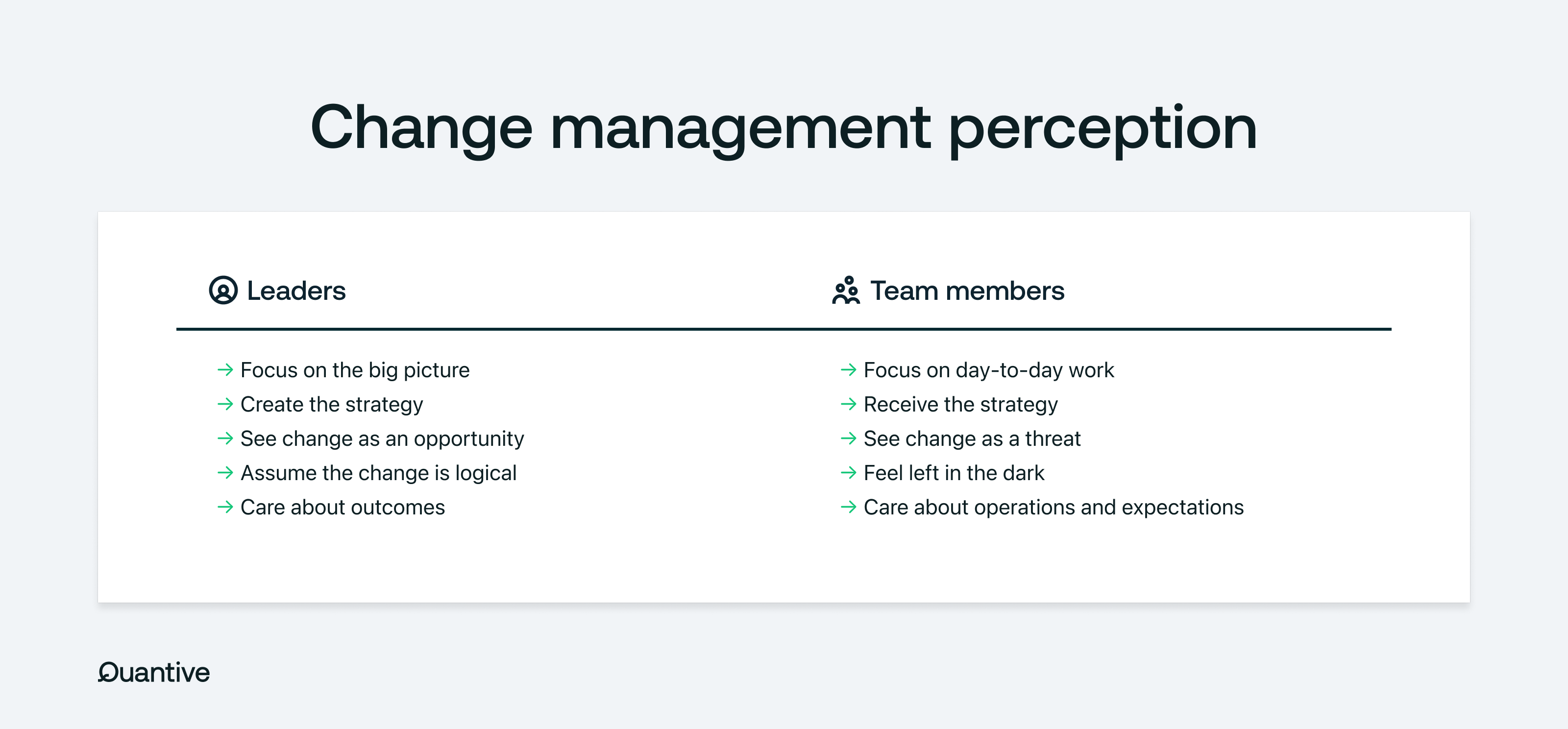
To minimize the negative effects of a changing strategy, as a leader, you'll need to have a very clear communication plan, introduce as much transparency as possible, and involve employees in shaping and implementing the strategy early on.
Let's see a possible game-plan structure.
8 steps to improve communication around shifting strategic priorities
1. Set the expectation that goals and priorities will shift
The best way to reduce the tension that comes with dynamic prioritization and business agility is to embed it into your company culture. Teams should always understand that things can change — and that's okay.
One of the easiest ways to set this expectation early is through your hiring process. Candidates should be comfortable with shifting priorities and see them as a natural and necessary part of business growth.
If your culture is already well-established, collaborate with your People and Talent team and CoS to reinforce this mindset through internal campaigns, workshops, and tailored activities that help teams embrace change rather than resist it.
Remember: When people anticipate and prepare for change, they are better equipped to cope. (NCBI)
Pro tip: At Quantive, we believe in the Always-On Strategy Model, which is why it's deeply integrated into Quantive StrategyAI. By keeping strategic goals dynamically updated and visible in real time, leaders ensure adaptability becomes second nature, reducing friction and misalignment during shifting priorities.
Learn more about the Always-On Strategy Model

2. Involve your teams early on
Most of the time, strategic shifts happen unexpectedly. One day (like any other), you schedule an All Hands meeting and announce the change. Suddenly, everyone is in shock. Projects are still in motion, but now some will need adjustments while others will be stopped altogether.
This kind of sudden shift can backfire quickly. Your teams should be involved in strategy discussions as much as possible to prevent resistance. They are closer to the day-to-day challenges and often have a better understanding of what's not working or what new trends are emerging.
Make regular feedback loops and strategy reviews a standard practice. When their insights validate your strategic assumptions, acknowledge it — let them know that thanks to their input, you're spotting new trends and opportunities that could lead to a change in direction.
Blindsiding them with unexpected shifts can lead to frustration and disengagement. If people don't see how their work contributes to the bigger picture, they'll feel unrecognized, and motivation will suffer.
Pro tip: Quantive StrategyAI facilitates weekly team check-ins, ensuring leaders and teams stay continuously aligned. By sharing what's working, what's lagging, and where support is needed, strategy adjustments become a natural, proactive process — often identified by teams.
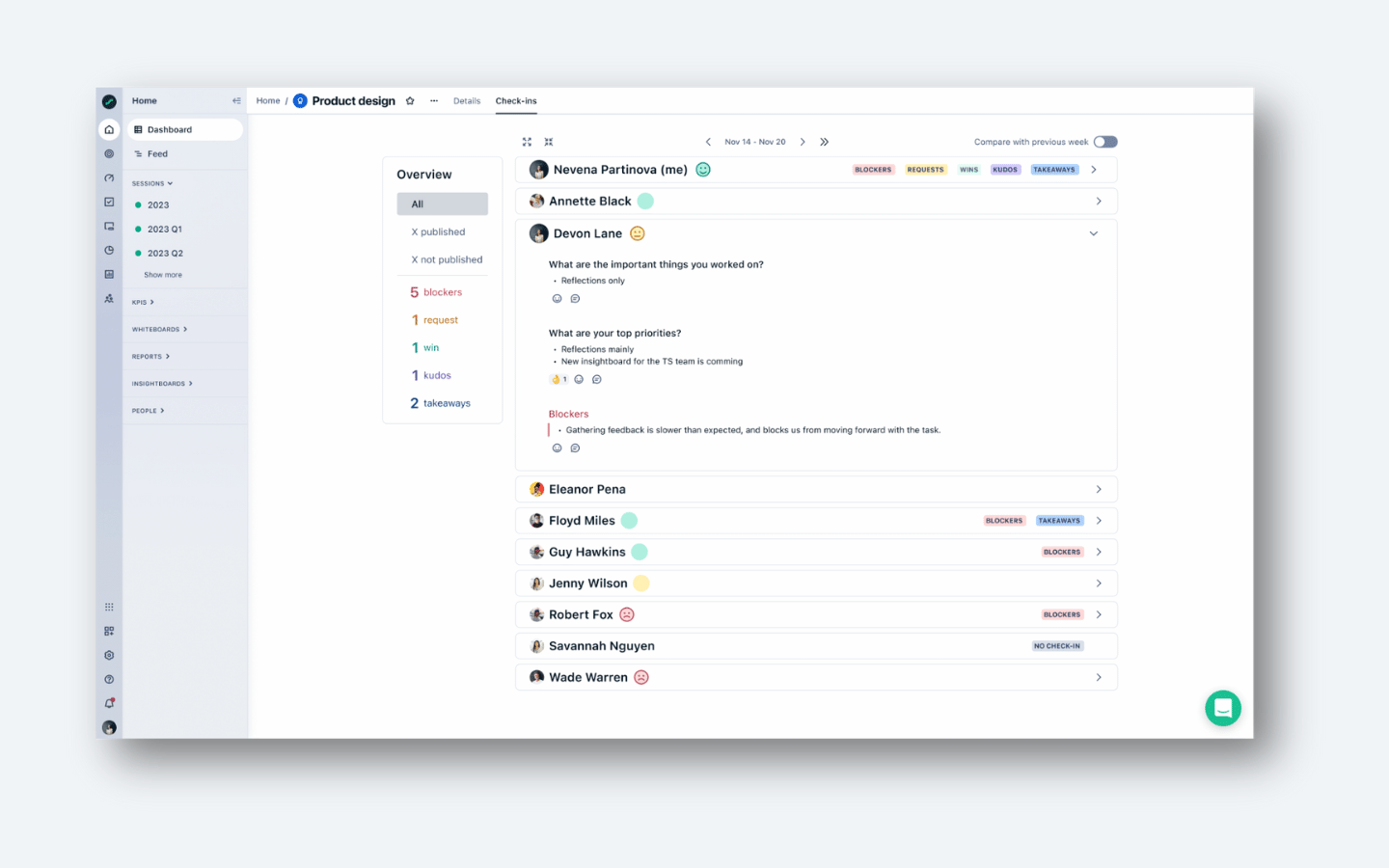
3. Communicate regularly on strategic progress and direction
If a month or quarter isn't going well, be upfront about it. Share exactly what's not working, the challenges, and what needs improvement. Your teams will appreciate the honesty and use these insights to adjust their approach proactively.
Alignment comes from consistent feedback, and helps everyone stay prepared for possible shifts. When communication is open and ongoing, changes won't feel like sudden disruptions. Instead, they'll be expected, understood, and much easier to navigate.
Pro tip: With Quantive StrategyAI's real-time dashboards and AI-powered insights, teams don't have to wait for quarterly review presentations to understand strategic progress. Strategic updates are automated and provide continuous visibility into execution, eliminating last-minute surprises.
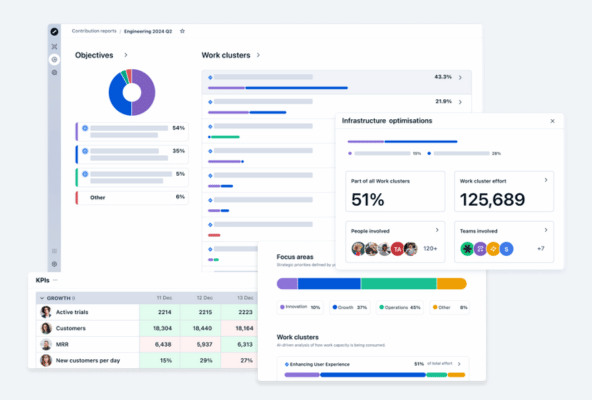
4. Tie the changes to the current mission and vision
Resistance fades when teams understand why change is necessary. Why continue if current activities no longer align with the company's mission and vision? Pushback is often emotional, but when you provide clear reasoning, people are more likely to accept the shift and see its purpose.
At this stage, sharing as much context as possible is crucial. Use concrete examples to explain the current state, why it's no longer working, and the ideal outcome in alignment with the company's vision.
Clarity and transparency are key. When people see the bigger picture, they won't just follow the change but embrace it.
Pro tip: Every strategic shift should be mapped to long-term business objectives. Quantive StrategyAI provides comprehensive executive summaries to ensure strategic changes are aligned with the company's mission and vision. This clarity reduces uncertainty and increases organizational commitment.

5. Open the stage for questions
Strategic shifts can be confusing. They imply that a different approach to work and strategy is expected. Allow your team members to bombard you with questions to clarify confusion.
Encouraging open dialogue helps employees process the change and gives the leadership valuable insight into potential roadblocks, transition challenges, and areas where teams may need extra support.
Change is a two-way process. The more questions asked, the more precise the path forward becomes for both sides, making the present more manageable and the future more certain.
Pro tip: Quantive StrategyAI serves as your single source of truth for strategic management. It integrates seamlessly with your existing tool stack, pulling critical data, KPIs, and insights. Teams can easily share strategic updates across communication channels — ensuring open dialogue, transparency, and collaborative discussions.
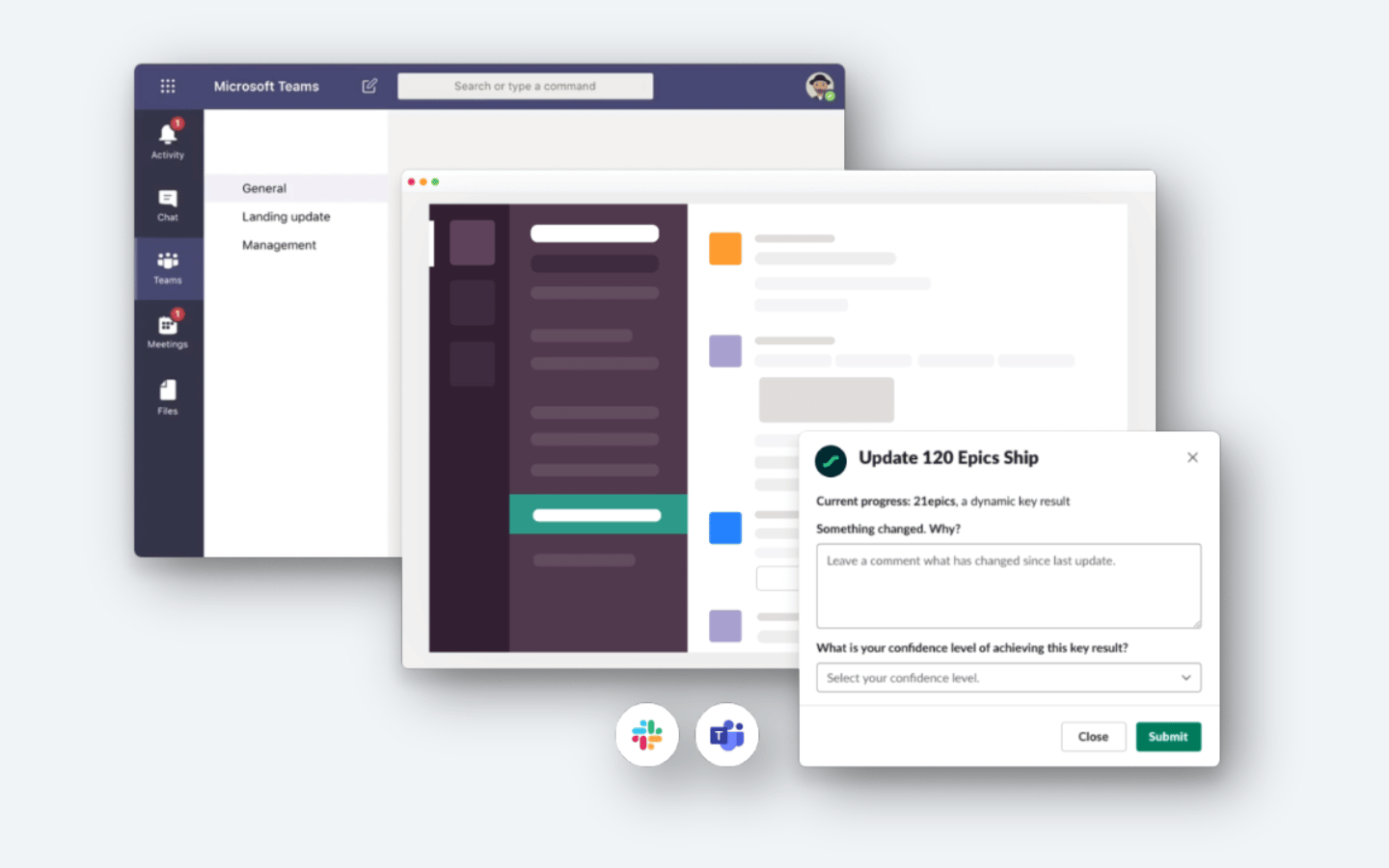
6. Review current progress and celebrate wins
Never dismiss what's already working — your team needs to know what should be carried forward, not just what needs to change. If you only focus on what's failing, you risk demotivating your workforce, leaving them thinking, "Once again, what we do isn't enough."
And that feeling? It's dangerous. When employees feel like nothing they do is ever good enough, they start looking elsewhere for recognition — or worse, they check out and do the bare minimum.
Instead, celebrate what's been accomplished. Give teams a well-deserved shoutout, acknowledge their efforts, and highlight wins — no matter how small. A culture of recognition and appreciation makes transitions smoother and helps break down resistance to change.
Pro tip: Your strategic progress lives inside Quantive StrategyAI. With an intuitive, visually appealing interface, leaders can spotlight strategic wins and keep the strategy actionable, not just documented and static.

7. Allow some time for the news to settle
One of the most stressful things you can do is change priorities overnight. Strategic shifts need time to settle in — or at least a heads-up. If you've followed the first steps of the list, your teams probably already sense that something is about to change.
A great approach is to separate the announcement of the shift from the introduction of new priorities. Give teams time to absorb the news, ask questions, and mentally prepare before diving into what's next. This small buffer makes transitions smoother, less overwhelming, and more effective.
Pro tip: Before shifting priorities, wrap up ongoing work seamlessly with Quantive StrategyAI. The platform enables teams to manage goals, projects, KPIs, and close existing workstreams to mentally prepare for what's next.
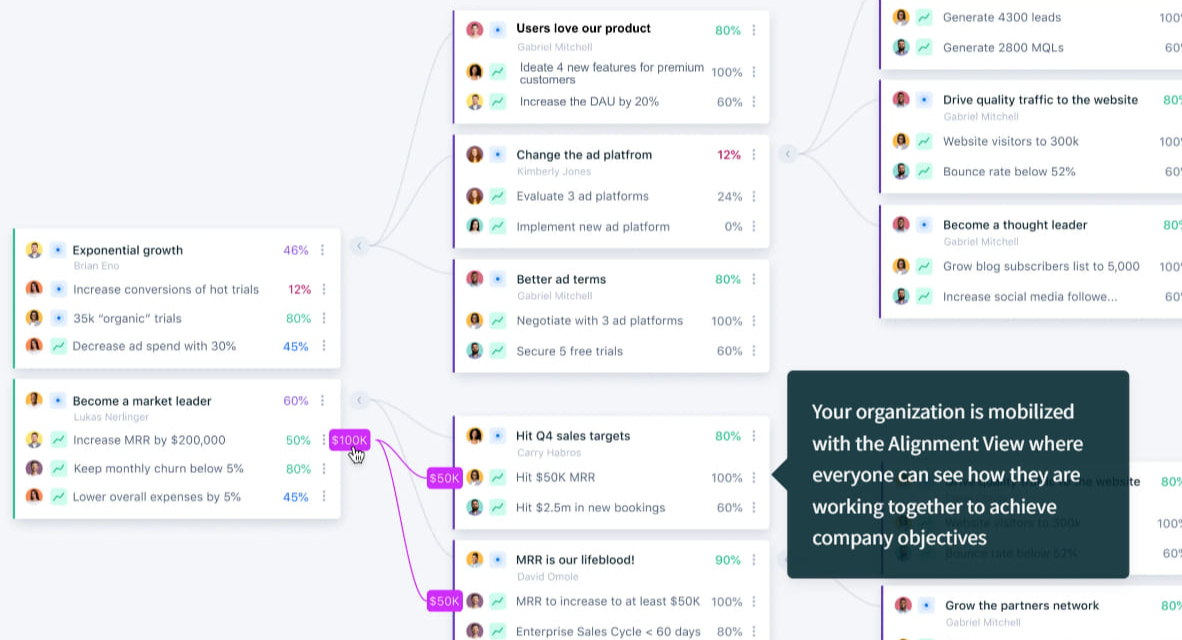
8. Plan introducing the new priorities
Before introducing new priorities, make sure everyone is fully aware that a change is coming. When the shift is well understood and you follow the best strategic planning practices, your teams will be open and receptive to what's next.
When it's time to announce, set a positive tone. Change is about growth and new opportunities, not uncertainty. Frame it as an exciting step forward so the organization feels motivated, not anxious.
Here's how you can plan your communication strategy:
- Get your leadership on board to align around the messaging
- Give a transparent company-wide announcement through all channels—an all-hands meeting, internal email, video recording, Coda/Confluence documentation, Slack message, and whatever channel your organization prioritizes.
- Show an easy-to-understand strategic roadmap with timelines, phases, milestones
- Clearly outline goals, KPIs, and strategic projects and make them public
- Hold departmental sessions to discuss team-level impacts
- Provide training and a resource library supporting the change
- Hold regular check-in cadency for progress updates and continuous feedback loops
Pro tip: Quantive StrategyAI provides a clear overview of your strategic plan, goals, and KPIs to ensure alignment at every level. Your teams understand not only what's changing, but why it matters.
Final takeaway
It's a cliché, but it's so true: The only constant in life is change. That's why spiritual leaders encourage us to live in the moment and appreciate what we have.
In business, however, leaders should express gratitude for progress and embrace change as a positive force. When leaders approach strategic shifts with enthusiasm and confidence, employees will follow. They will truly embrace the "implement and improve" mindset.
Change is about growth — not pain and suffering.
Are you planning to shift strategic priorities? Prepare your teams with a structured approach. Try Quantive StrategyAI and plan for success.





